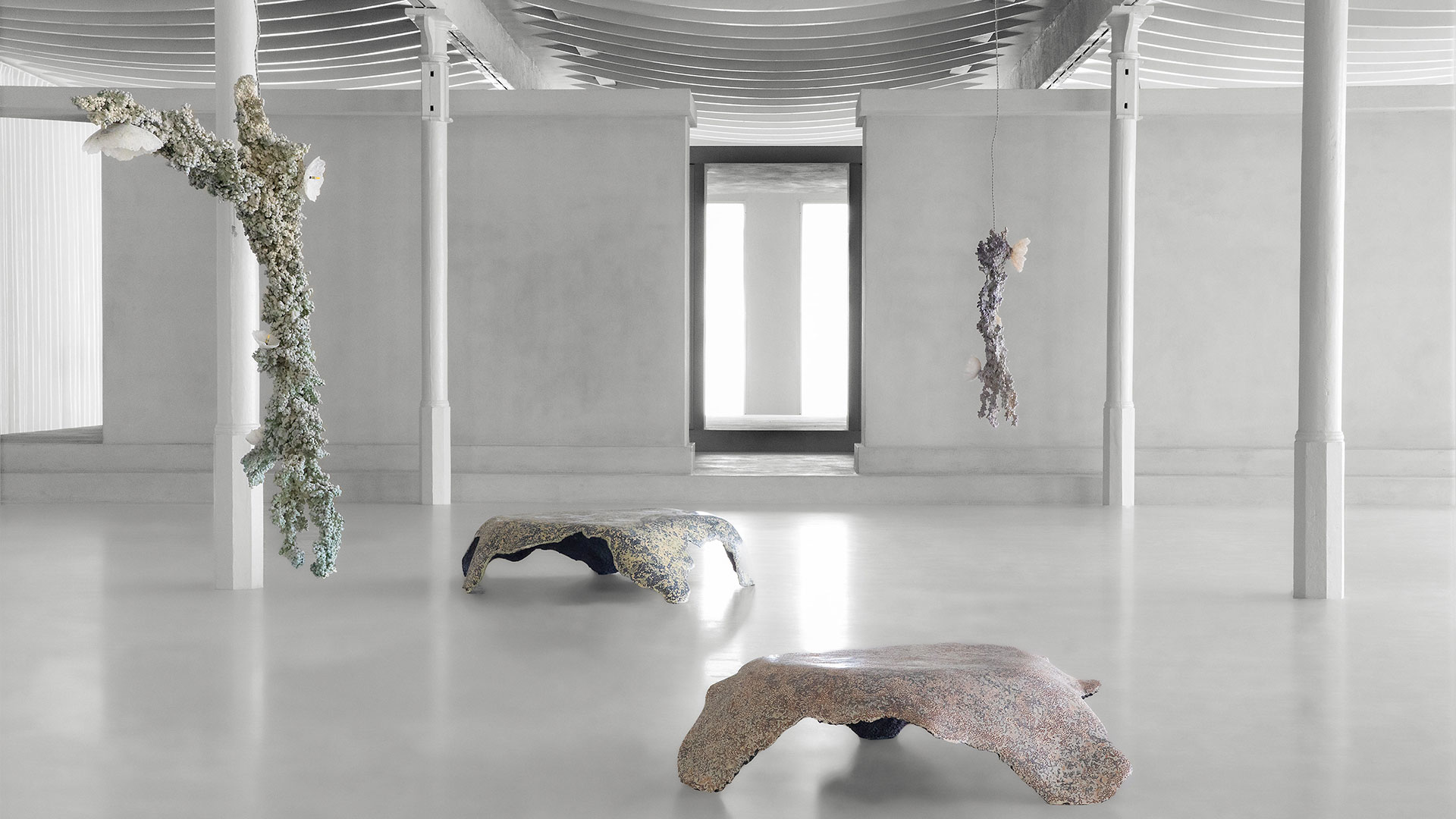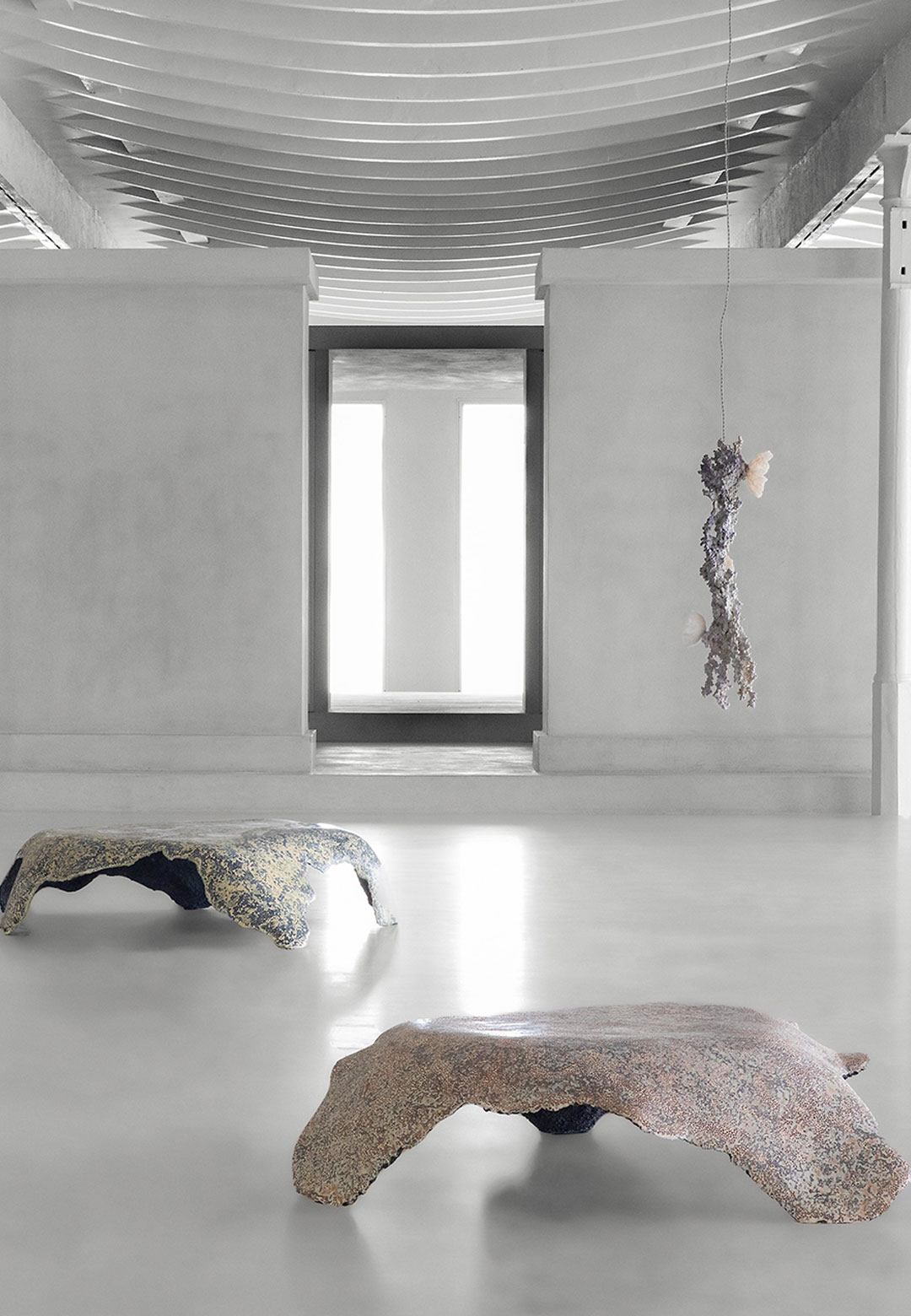Alluding to the mystical underwater ecosystem, French designer Elissa Lacoste’s lamps, tables, stools, benches, chandeliers, and racks—with shapes and textures inspired by corals, sea flowers, minerals, fossils, speleothems, and other natural and geological elements—dot the spaces of Side Gallery in Girona, Spain. On view from November 9, 2022 to February 14, 2023, the exposition, titled Infinito Viviente, is the designer’s first solo exhibition with the Spanish gallery. The name of the showcase, the objects displayed across Side Gallery’s Casavells location, and the exhibition design bear reference to 19th-century poet and novelist Jules Gabriel Verne’s science-fiction novel Twenty Thousand Leagues Under the Sea. “The scientific popularisation that the author has made through the passion for biodiversity and the natural sciences of the narrator inspired me a lot, as he describes thoroughly all the species, landscapes and phenomenons he encounters through his journey on board of the Nautilus,” Lacoste asserts.
Verne’s description of the sea is resplendent in the details and description of the biomorphic creations. Forecasting a future when in-depth exploration and inspection of the sea would be possible, the French novelist wove a layered narrative, in which characters undertake elaborate journeys and transcend challenging portals in the seas and oceans of the world. In the process, the protagonists explore uncharted territories—remote islands, deep-sea creatures, the mythical city of Atlantis and the depths of the South Pole. Evoking this vibrant scenery, Lacoste’s biomorphic creations give a glimpse into the magic that unfurls under the covert covers of shiny water surfaces.
Infinito Viviente reverberates with Verne’s description of the sea: “It's an immense wilderness where a man is never lonely, because he feels life astir on every side. The sea is simply the vehicle for a prodigious, unearthly mode of existence; it's simply movement and love; it's living infinity.”
Lacoste, who was born in France and continues to reside in the country, can best be described as an experimental designer. Most of her creations begin with a search for wilderness and the unknown. While her creations fall under the bracket of contemporary design, Lacoste does not shy away from exploring unconventional textures and materialities, such that the final product by the designer always manages to evoke surreal emotions while also fulfilling any pragmatic role accredited to the object. In creating sculptural objects that are organic in form and tactility, the designer invites viewers to touch and explore them as they would with a natural creation.
Drawing inspiration from the serendipitous nature of life, Lacoste lets her instinct guide her process instead of using formalised methods and techniques. She allows herself to be lost in natural sites, where she scavenges for material and muses. A similar instinctual urge guided her to create a sculptural microcosm that mimics the aquatic ecosystem. By channelling the vision inked by Verne in Twenty Thousand Leagues Under the Sea, she manages to combine the surrealism of underwater life with supernatural charm. "The exhibition displays one-of-a-kind functional pieces, gathered in a collection celebrating diversity and uniqueness. Each piece acts as a unique specimen like in a cabinet of curiosities that aims to talk about an imaginary seascape populated by never-seen beings," Lacoste shares.
While the Shagreen tables by Lacoste are inspired by the movement of sea rays, as seen through the crystal windows of the submarine Nautilus, in Verne’s novel, the Hermit stool, as described by Lacoste, “evokes an argonaut, a hermit crab or any mollusk or crustacean living in an adopted shell, while translucent and wobbly silicone flowers provide light on calcified structures resembling coral growth or petrified floating algae.” The Epilith lamps, which resemble prickly wild plants—with forms that mimic mineral stratifications, metal nugget formations, and semi-translucent wobbly elements—coming from unexpected places, serve as a warning to the swiftly disappearing natural entities around us.
On the other hand, as a consequence of constant layering and sanding of unlikely materials, her collection of floor and table lights mimics the diagenetic processes of a wide variety of sedimentary rocks in their various colourful and sparkling textures and appearances. These monolithic pieces combine into reef-like assemblages made of cast aluminium that look like they are in the process of metamorphosing. This sudden invitation into the making process is softened by the touch of soft translucent silicone wild flowers, showcasing yet another talent Lacoste possesses, that of mixing and matching unexpected elements. Lacoste wanted her creations to mimic the diversity of the lives that populate the space under the sea. With her distinct body of work, comprising 21 functional sculptures, she melds function and art, the natural with the artificial, and experiments with experience.
Lacoste creates a cognitive dissonance in the audience by defamiliarizing the familiar and familiarising the unfamiliar, as seen in her stone-like silicone pieces that are fossilised with traces of earthly materials and powders, like the pierre de Bourgogne—an authentic French stone flooring—she collected and sifted herself for this series. Describing her process, she says, "My creative process is itself inspired by the formation of matter by the forces of nature. I start with a vision, a texture, a material, a volume, a function, or a spatiality that I want to achieve as a guide through the process, but it is very common that the pieces turn out unexpectedly throughout material manipulations. I love playing with the different states of matter, melting from solid to liquid and solidifying again by creating interactions with other substances, or discovering weird reactions that are sometimes exploitable as a new texture, sometimes not." Lacoste combines aluminium with mineral resin, mica, graphite, various mineral aggregates, or silicone, in order to juxtapose opaque and translucent materials.
In her work, Lacoste celebrates the process of breaking expectations by gathering things, assembling them, and letting them interact to create morphing synthetic topographies and rebellious biomes inside the confines of the modern world. Elissa's collection speaks of the diversity that was or could be, with materials flowing free from oppression, just like the marine muses that inspire her work.






 Sign in with email
Sign in with email










What do you think?